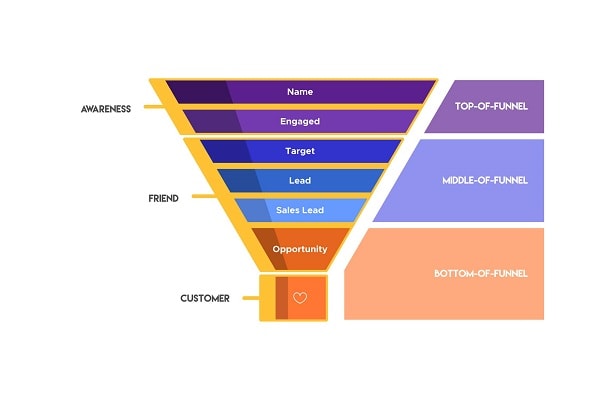Search intent and its importance in SEO are well understood by marketers, and it’s highly recommended to take a closer look at search intent when targeting organic keywords.
While many articles have been written on SEO blogs concerning search including the most popular informative blogs on creating content to match search intent and user search behavior. Most of them tend to lack clear advice on prioritizing keywords for a brand.
Typically, discussions on search intent highlight the fact that search queries can be categorized into three types: informational (seeking knowledge about a topic), comparative (looking for solutions to a problem), and transactional (seeking to make a purchase). These categories are often represented as a marketing funnel.
 From our years of experience in creating SEO-driven content for hundreds of brands, we have concluded that for most companies, it’s not worth dividing the importance of content across the funnel. It simply works better to focus on the bottom of the funnel content and work upwards.
From our years of experience in creating SEO-driven content for hundreds of brands, we have concluded that for most companies, it’s not worth dividing the importance of content across the funnel. It simply works better to focus on the bottom of the funnel content and work upwards.
The primary reason is that SEO resources are not infinite, and content targeting the bottom of the funnel in search queries with “transactional” search intent will deliver way more return on your investment compared to any other type of content.
It’s Impossible to Effectively Target all Keywords.
The common recommendation that companies should have content for all stages of the marketing funnel, representing all search intents, would be ideal if they had unlimited SEO resources – such as an abundance of writers to produce content, a surplus of SEO strategists to select keywords and conduct SERP analysis, and an unlimited budget for link building. However, the reality is that no brand possesses such limitless resources.
Even with the rise of AI-assisted writing which can generate a high volume of content in minimal time is not going to change that base constraint. While the ability of AI tools to generate thousands of content is there, that will not mean all of the content will rank or meet the standards to impress your potential customers and drive conversions.
If several sites have the same AI-assisted content that targets the same keywords, then Google would have to differentiate between these to decide which ones to rank. The probable factors Google may consider here are content quality and backlinks.
Content quality is likely to be a key determinant, favoring contents that demonstrate creativity and particular personal knowledge skills that Google has explicitly stated a preference for, and which require human intervention.
Backlinks have been a well-known ranking factor in SEO for a long time. In a scenario where numerous sites produce comparable AI-generated content for the same keywords, backlinks will probably remain just as, if not more, significant.
You may also like: Site Optimization Tips for eCommerce in 2024
Therefore, regardless of how content is produced, the SEO resources for everyone are finite. There is a limited number of employee hours, a restricted writing budget (whether AI is used or not), and a finite link-building budget.
This reality demands that companies prioritize the keywords they target. The most logical approach to prioritization is to focus SEO efforts on what will yield the highest ROI – in other words, generating leads and sales attributable to SEO. In our years of experience, bottom-of-funnel, transactional keywords drive such ROI.
BOFU Keywords Drive Substantially Higher Conversions than Other Types of Keywords
In short, to determine whether or not bottom-of-funnel content drives substantially higher conversions than other types of content, the very first critical step is to actively measure and track conversions derived from SEO efforts.
Surprisingly, most SEO and content teams skip this step and focus directly on increasing traffic, and assume that more traffic will automatically bring better results.
To effectively measure conversions from SEO, several analytics tools can be used, but in general, the process involves the following:
- Clearly define what a conversion means, whether it’s a form submission, a trial signup for SaaS or sales-based businesses, or a completed transaction for e-commerce businesses.
- Create an explicit goal in your analytics to track and measure these conversion events.
- Run comprehensive reports that show which landing pages of your website have contributed to how many conversions. Using various attribution models, such as first or last-click attribution depending on your analytics platform, will be extremely insightful, and any data is better than no data.
Specifically, we have found that pages on a website ranking for bottom-of-funnel keywords experience conversion rates in the range of single-digit percentages (1% – 5%), whereas pages ranking for top-of-funnel, informational keywords typically achieve conversion rates of a fraction of a percent (0.01% – 0.5%).
In essence, the disparity in conversion rates between bottom and top-of-funnel keywords is not marginal – it is multiple times higher.
This disparity is clearly illustrated by the data we have gathered from over 60 content pieces created for one of our software clients, where content targeting bottom-of-funnel queries achieved an average conversion rate 25 times higher than articles focused on mid to top-of-funnel queries.
The conversion rates for bottom-of-funnel posts were significantly higher at 4.78%, in contrast to a mere 0.19% for top-of-funnel posts. These results were derived from an analysis of over 60 posts for a specific client.
Even when considering the fact that top-of-funnel pieces may attract more traffic, the actual number of conversions from just 20 bottom-of-funnel posts was three times greater than the combined conversions from 40 top-of-funnel posts:
20 bottom-of-funnel posts resulted in an impressive 1,348 conversions, while 40 top-of-funnel posts yielded 397 conversions.
You may also like: Ways to Enhance Page Speed for Increased Traffic and Conversions
It’s worth emphasizing that the 1,348 conversions from bottom-of-funnel content were achieved with just 22 pieces, whereas the 397 conversions from top-of-funnel content required 42 articles.
Furthermore, it’s essential to note that the articles labelled as “top of funnel” in this study still had some level of buying intent. They were pursued only after exhausting most bottom-of-funnel keywords, and the chosen keywords were strategically selected to retain a chance of conversion.
In fact, one could argue that these articles could be seen as falling into a “mid-funnel” category, given their potential for conversions. However, many companies tend to focus a significant portion of their content and SEO efforts exclusively on top-of-funnel keywords, hoping for leads or sales at or below the conversion rates mentioned above.
What causes informational, top-of-funnel keywords to have such low conversion rates?
The common argument in favour of pursuing top-of-funnel keywords is their high search volumes. The belief is that by targeting these keywords, you can expose your brand to a large audience, many of whom may require a product or service like yours in the future.
However, as the data provided above and our collective experience have confirmed, converting top-of-funnel traffic into actual customers involves several steps, leading to extremely low conversion rates.
Specifically, the journey from someone conducting a top-of-funnel informational search to becoming a customer involves the following steps:
- They perform a Google search for the query.
- They click on your search results and visit your article.
- A portion of these users might either return to your site from memory or provide their email to access a white paper or gated resource.
- A fraction of those users will then open subsequent drip emails.
- At some point, a small percentage of these users will express the need for your product or service and reach out.
Each of these steps carries a modest conversion rate, resulting in an overall journey with an exceedingly minute conversion rate.
In fact, the data presented above illustrates that even with possibly higher search volumes for top-of-funnel queries compared to transactional queries, the tiny conversion rates fail to compensate for the disparity.
There is a greater abundance of bottom-of-funnel keywords than you might realize.
If you believe that prioritizing bottom-of-the-funnel keywords is a more effective allocation of limited SEO resources than spreading content evenly across the entire spectrum of search intent, the next crucial question to address is: “Which keywords within my niche are bottom-of-the-funnel and exhibit high conversion rates, and how many such keywords exist?”
We’ve observed that many SEO professionals and marketers tend to have a restricted perspective on what qualifies as bottom-of-the-funnel keywords – ones that indicate some level of transaction or buying intent.
You may also like: The Importance of Categories and Structure Over Content in SEO
In our experience, we have identified three primary categories of bottom-of-the-funnel keywords, with only the first category typically being recognized as such.
-
Category Keywords
Let’s consider a hypothetical business that we’re all familiar with – SEO software. The obvious transactional keywords in this context would be phrases like “SEO software” or “best SEO tools.” Undoubtedly, these are highly converting bottom-of-the-funnel or transactional keywords that any SEO software brand should unquestionably target.
In our SEO framework for bottom-of-the-funnel (BOTF) SEO, we refer to these keywords as “category keywords” since they involve users directly searching for the name of the product or service category.
Most SEO and marketing teams are aware of these keywords and do target them, often using their homepage or a couple of landing pages.
However, what we’ve discovered is that many teams consider this limited set of category keywords to be the entirety of their bottom-of-the-funnel or transactional keyword strategy. They focus on a few category keywords and devote the rest of their efforts to creating blog content to rank for top-of-funnel search terms, which typically have lower conversion rates.
In reality, there are numerous other high-converting search terms that most brands tend to overlook and ignore while prioritizing content creation for low-converting top-of-funnel keywords.
-
Comparison Keywords
Another highly lucrative category of keywords that shouldn’t be overlooked is what we refer to as “comparison keywords.”
These are search terms that indicate the user is in the process of comparing multiple options, such as “salesforce vs Pipedrive” or “Adidas vs Nike women’s running shoes.”
While some discussions on search intent label these as mid-funnel queries, suggesting that searchers might only be conducting product research and not yet ready for a transaction, our extensive analysis of conversion rates from hundreds of pages ranking for comparison keywords has revealed that they often convert just as well as the category keywords mentioned earlier.
Therefore, from my perspective, companies aiming to maximize ROI from their SEO efforts should proactively target comparison keywords. Identifying every relevant comparison keyword related to their top competitors, regardless of the search volume, and ensuring the presence of dedicated pages on their site to rank for each of these keywords can prove highly beneficial.
-
Jobs To Be Done Keywords
The third and largest category of high-buying-intent keywords we’ve identified are known as “jobs to be done” keywords.
Despite their potential for generating conversions, this category is often overlooked or not given priority by brands. Jobs to be done keywords are queries where users are not explicitly seeking or comparing product options, but they indicate that they have a problem, and your product happens to provide a solution.
For instance, in the context of an SEO software example, these queries could include phrases like “how to do competitor keyword research,” “how to determine search volume of keywords,” or “how to track the keywords a website ranks for.”
Our experience suggests that if you have an SEO software product with features that address these needs, ranking for keywords like these can indeed lead to conversions.
Typically, the conversion rate of these keywords is slightly lower than that of category or comparison keywords.
Nonetheless, they still outperform top-of-funnel queries like “SEO strategy,” “best SEO tips,” or even “digital marketing strategies.” These latter terms are the typical top-of-funnel keywords companies pursue, but they exhibit minimal buying intent.
Would you like to read more about the importance of Bottom Of Funnel keywords in SEO for Brands-related articles? If so, we invite you to take a look at our other tech topics before you leave!
Use our Internet marketing service to help you rank on the first page of SERP.
![]()










